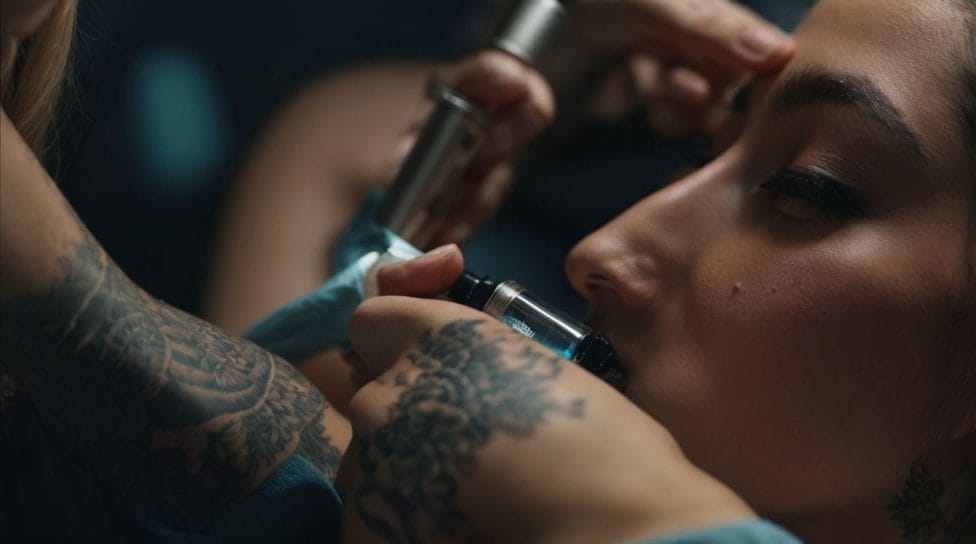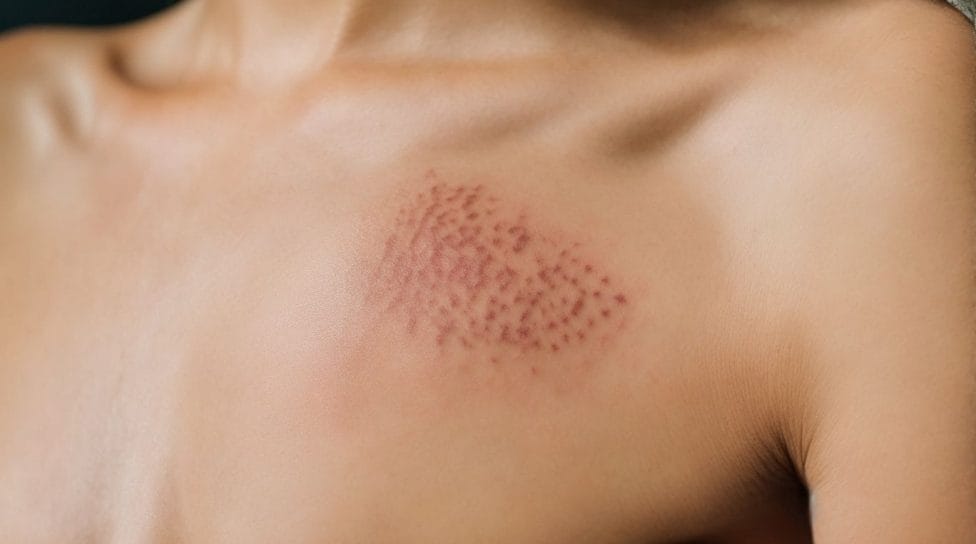Tattoos are a popular form of self-expression, but sometimes, circumstances change, and the desire for their removal arises. If you’re considering tattoo removal, it’s natural to have concerns about its safety. Understanding the methods of tattoo removal and the associated risks and precautions can help you make an informed decision. Here is what you need to know.
There are various methods of tattoo removal available, including laser tattoo removal, surgical tattoo removal, and topical creams and lotions. Laser tattoo removal is the most common and effective method, using laser technology to break down the tattoo pigment. Surgical tattoo removal involves cutting out the tattooed skin or using skin grafting techniques. Topical creams and lotions work by gradually fading the tattoo over time.
Now, let’s address the main question: Is tattoo removal safe? While tattoo removal is generally considered safe, it’s essential to be aware of potential risks and side effects. These can include skin irritation, scarring, changes in skin pigmentation, and infection. Factors such as the size and color of the tattoo, the type of removal method used, and individual skin characteristics can affect the safety and outcome of the procedure.
Choosing a reputable and safe tattoo removal clinic is crucial to minimize risks. Researching the clinic’s reputation and ensuring they have qualified and experienced professionals is vital. It’s also important to inquire about their safety measures and the equipment they use to perform the tattoo removal procedure.
Aftercare and recovery play a significant role in the safe removal of tattoos. Managing pain and discomfort, following proper wound care protocols, and preventing infections are essential during the healing process. Your tattoo removal specialist should provide detailed instructions and guidelines to promote a safe and healthy recovery.
Alternative tattoo removal methods, such as DIY tattoo removal techniques and covering up the tattoo with another tattoo, may seem tempting, but they are generally not recommended. These approaches can lead to further complications, scarring, and unsatisfactory results.
While tattoo removal is generally safe, it’s important to consult with a qualified professional who can assess your specific situation and provide personalized advice. By understanding the methods, risks, precautions, and aftercare involved, you can make an informed decision and ensure a safer tattoo removal process.
Key takeaways:
- Tattoo removal methods have varying levels of safety: Laser tattoo removal is generally considered safe, while surgical methods carry more risks. Topical creams and lotions may be less effective and can cause skin irritation.
- Proper research and choosing a reputable clinic is crucial: Ensuring the clinic has qualified and experienced professionals, as well as adequate safety measures and equipment, significantly reduces the risks associated with tattoo removal.
- Aftercare and proper recovery methods are essential: Managing pain and discomfort and preventing infections during the healing process are crucial for safe tattoo removal. Following recommended aftercare guidelines ensures a smoother recovery.
Methods of Tattoo Removal

Photo Credits: Tattooineplanet.Com by Juan King
When it comes to tattoo removal, there are several methods you can consider. In this section, we’ll dive into the various options available, including laser tattoo removal, surgical tattoo removal, and topical creams and lotions. Find out the key facts, pros, and cons of each technique, and discover which method might suit your needs best. So, if you’re curious about bidding farewell to your tattoo, keep reading to explore the world of tattoo removal methods!
Laser Tattoo Removal
Laser tattoo removal is a highly sought-after technique for eliminating undesired tattoos. Here is a step-by-step guide to the process of laser tattoo removal:
- Consultation: Initiate an initial consultation with a qualified dermatologist or laser specialist.
- Evaluation: The specialist will evaluate your tattoo, skin type, and medical history to determine the suitability of laser tattoo removal for you.
- Preparation: Before the treatment, you may be advised to avoid sun exposure and specific skincare products.
- Treatment: Throughout the session, the laser emits powerful light pulses to dismantle the tattoo’s ink gradually.
- Sensation: You may experience slight discomfort, often likened to the sensation of a rubber band snapping against the skin.
- Multiple sessions: Complete tattoo elimination typically necessitates multiple sessions with several weeks in between.
- Aftercare: It is essential to follow the post-treatment instructions, which entail applying ointments and shielding the treated area from excessive sun exposure.
Fun fact: The mechanism of laser tattoo removal involves directing high-energy light beams at the pigment particles in the tattoo ink, causing the ink to fragment and fade gradually.
Surgical Tattoo Removal
Surgical tattoo removal, also referred to as excision, is a process that entails physically cutting out the tattooed skin from the body. Below are the steps involved in the process of surgical tattoo removal:
- Consultation: Schedule a consultation with a competent and experienced dermatologist or plastic surgeon to discuss your goals for tattoo removal and determine if surgical removal is the most suitable option for you.
- Anesthesia: The designated area for treatment will be numbed using a local anesthetic to minimize discomfort during the procedure.
- Incision: The surgeon will meticulously make incisions around the tattooed area to eliminate the tattooed skin. The size of the incision will vary depending on the size and intricacy of the tattoo.
- Suturing: After removing the tattooed skin, the surgeon will utilize sutures to close the incision. This aids in proper healing and reduces the formation of scars.
- Recovery: Adhere to the post-operative instructions provided by your surgeon, which include appropriate wound care, pain management, and avoiding activities that could impede the healing process.
- Follow-up: Attend all scheduled follow-up appointments to ensure the incision is healing correctly and to address any concerns or complications that may arise.
Surgical tattoo removal is most effective for smaller tattoos, but it may not be suitable for larger or intricate designs. It is vital to consult with a qualified professional to determine the optimal course of action for your specific tattoo removal needs.
Topical Creams and Lotions
Topical creams and lotions, such as the ones mentioned, are commonly used for tattoo removal. They function by breaking down the ink pigments, which allows the body to gradually eliminate them naturally. When deciding on a topical cream or lotion, it is crucial to consider its effectiveness, ingredients, and potential side effects. It is advisable to seek out products proven to deliver results and have received positive customer reviews. To ensure compatibility with your skin type and tattoo, consulting with a dermatologist or a tattoo removal specialist is recommended. It is important to remember that consistency and patience are key factors when using topical creams and lotions as part of your tattoo removal regimen.
Is Tattoo Removal Safe?

Photo Credits: Tattooineplanet.Com by Walter Wright
Tattoo removal is a hot topic, but let’s cut to the chase—is it safe? In this section, we’ll uncover the truth behind the safety of tattoo removal. We’ll dive into the potential risks and side effects that might come with it, as well as the factors that influence its overall safety. Prepare to separate fact from fiction and make an informed decision about tattoo removal. It’s time to get the lowdown on safety!
Potential Risks and Side Effects
Potential Risks and Side Effects of tattoo removal procedures must be considered before undergoing the process. These risks include:
- Scarring: Laser tattoo removal can cause scarring, particularly in individuals with darker skin tones.
- Skin discoloration: Hyperpigmentation or hypopigmentation may occur, resulting in darkening or lightening of the skin in the treated area.
- Infection: There is a risk of infection if post-treatment care is not followed properly.
- Allergic reactions: Some individuals may be allergic to the tattoo removal solution or ink.
- Pain and discomfort: The process can be painful, and some discomfort may persist during the recovery period.
- Healing time: The treated area may take weeks or months to fully heal, depending on the individual and the removal method used.
Factors Affecting the Safety of Tattoo Removal
When considering tattoo removal, several factors can affect the procedure’s safety. These factors, including the type and color of the tattoo, the location on the body, the skill and experience of the professional performing the removal, and the aftercare practices, play a crucial role in ensuring a safe process. It is important to acknowledge that darker and more complex tattoos may require multiple sessions, increasing the risk of complications. Furthermore, the location of the body can impact healing and potential scarring. Therefore, it is of utmost importance to thoroughly research and choose a reputable clinic with qualified professionals and proper safety measures and equipment.
Additionally, following proper aftercare instructions is essential for a safe and successful tattoo removal process. To guarantee the safety of tattoo removal, carefully consider factors such as tattoo characteristics, professional expertise, and appropriate aftercare. By taking these factors into account, you can minimize the risks involved and achieve the best possible results.
Choosing a Safe Tattoo Removal Clinic

Photo Credits: Tattooineplanet.Com by Mark Thomas
Are you looking to get rid of that tattoo? Let’s dive into the essential factors when choosing a safe tattoo removal clinic. From researching the clinic’s reputation to ensuring qualified professionals and top-notch safety measures and equipment, we’ll cover all the crucial aspects you need to know. So, buckle up and prepare to make an informed decision in your journey towards tattoo removal!
Researching the Clinic’s Reputation
When researching the reputation of a tattoo removal clinic, it is essential to consider several factors.
- Online reviews: Look at the positive or negative feedback from previous clients regarding their experiences at the clinic.
- Testimonials: Find testimonials from satisfied customers who have successfully undergone tattoo removal treatments at the clinic.
- Before and after photos: Assess the clinic’s success rate by examining before and after photos of previous clients.
- Referrals: Ask trusted friends or family members who have had tattoo removal at reputable clinics for recommendations.
- Professional affiliations: Determine if the clinic is associated with recognized tattoo removal organizations, which shows their commitment to quality and safety.
Taking the time to research the reputation of a clinic thoroughly can help ensure a safe and successful tattoo removal experience.
Qualified and Experienced Professionals
Qualified and experienced professionals are indispensable when it comes to tattoo removal. When selecting a tattoo removal clinic, consider the following factors:
- Researching the clinic’s reputation: Look for a clinic with positive reviews and testimonials from previous clients.
- Qualified and experienced staff: Ensure that the clinic has professionals who are certified and trained in tattoo removal procedures.
- Safety measures and equipment: Check if the clinic follows proper safety protocols and has modern equipment for effective and safe tattoo removal.
By opting for a clinic with qualified and experienced professionals, you can have peace of mind knowing that you are in capable hands during the tattoo removal.
Safety Measures and Equipment
Safety measures and equipment are crucial in ensuring safe tattoo removal procedures. When choosing a clinic or technician, it is important to consider the following:
- Research the clinic’s reputation: Look for reviews and feedback from previous clients, ensuring that the clinic follows safety protocols.
- Qualified and experienced professionals: Ensure that the clinic employs trained and certified technicians with experience in tattoo removal procedures.
- Proper safety measures and equipment: Verify that the clinic uses state-of-the-art equipment and follows proper safety protocols, such as using protective eyewear and gloves during the procedure.
Considering these factors, you can ensure a safe and effective tattoo removal experience.
Aftercare and Recovery

Photo Credits: Tattooineplanet.Com by Lawrence Ramirez
Recovering from tattoo removal is just as important as the removal process itself. In this section, we’ll dive into aftercare and recovery methods that will help you navigate both the physical and emotional aspects. We’ll explore effective ways to manage pain and discomfort, as well as share crucial tips on preventing infections to ensure a safe and successful healing process. Let’s look at the key steps for a smooth recovery journey.
Managing Pain and Discomfort
Managing pain and discomfort is a crucial aspect of tattoo removal. To help alleviate any discomfort during the process, here are some steps you can take:
- Before the tattoo removal procedure, apply a topical numbing cream or gel to the area.
- Follow the instructions of your healthcare provider and take over-the-counter pain relievers such as ibuprofen or acetaminophen.
- To reduce swelling and numb the area, you can use ice packs or cold compresses on the treated area.
- Your tattoo removal specialist will provide aftercare instructions, including keeping the area clean and moisturized. Make sure to follow them.
- Avoid exposing the treated area to extreme temperatures, excessive sweating, or sun exposure, as they can intensify pain and discomfort.
A prime example from history of effectively managing pain and discomfort is the utilization of opium as an anesthetic during surgeries in ancient civilizations like Ancient Egypt and Ancient Greece. Opium, derived from the poppy plant, was widely known for its pain-relieving properties. However, it was highly addictive and carried significant risks and side effects. Today, we have advanced and safer methods to manage pain and discomfort during tattoo removal.
Preventing Infections
Preventing infections is a vital component in ensuring a safe and successful tattoo removal procedure. To achieve this, follow these essential steps:
- Ensure Cleanliness: It is crucial to keep the treated area clean by gently washing it with mild soap and warm water.
- Use Bandaging: Cover the area with a sterile, non-stick bandage to protect against dirt and bacteria.
- Avoid Touching: Avoid touching the treated area with unclean hands to minimize the risk of introducing bacteria.
- Avoid Swimming: Until the area is fully healed, avoid swimming in pools, hot tubs, or natural bodies of water to prevent infection.
- Avoid Excessive Moisture: Keep the treated area dry and avoid exposing it to excessive moisture, as it can create an ideal environment for bacteria to grow.
- Follow Aftercare Instructions: To diminish the risk of infection, strictly adhere to any aftercare instructions from your tattoo removal professional.
Alternative Tattoo Removal Methods

Photo Credits: Tattooineplanet.Com by Jerry Baker
Are you looking to bid farewell to an unwanted tattoo? This section explores alternative methods for tattoo removal, steering clear of the traditional laser approach. Get ready to discover two intriguing sub-sections that unlock new possibilities: do-it-yourself tattoo removal and the art of covering up with another tattoo. Brace yourself for eye-opening insights and innovative approaches that could be the key to saying goodbye to that ink you no longer desire.
Do-It-Yourself Tattoo Removal
Do-It-Yourself Tattoo Removal methods are strongly discouraged due to the inherent risks and potential complications. If you still decide to proceed, here are some suggested steps to follow:
- Thoroughly research various Do-It-Yourself methods for Tattoo Removal, including using tattoo removal creams or natural remedies.
- Prioritize consulting with a qualified dermatologist or professional specializing in tattoo removal to comprehend the potential risks and complications fully.
- Follow the instructions diligently and utilize any recommended tools or products as directed.
- Before applying the method to the entire tattooed area, always perform a patch test on a small portion of your skin.
- Patience and consistency are key throughout the treatment process since visible results may not be immediate, and multiple sessions may be required.
- Carefully monitor your skin for any negative reactions or signs of infection during and after the treatment.
- If you encounter any complications or experience any negative effects, promptly seek immediate medical attention.
It is crucial to remember that opting for Do-It-Yourself Tattoo Removal methods may not yield the same effectiveness as professional treatments and could result in scarring or other skin damage. To ensure safe and successful results, it is always recommended to consult with a qualified tattoo removal professional.
Covering Up with another Tattoo
Covering up a tattoo with another tattoo, known as a cover-up tattoo, has become a popular alternative to tattoo removal. This method allows individuals to transform or hide unwanted tattoos by seamlessly incorporating them into a new design. When opting for this approach, there are several factors to consider:
- Design choice: It is crucial to select a design that fully covers the existing tattoo while aligning with your aesthetic preferences.
- Tattoo artist expertise: Working with a skilled tattoo artist with experience in cover-up tattoos is essential as they possess the specific techniques and knowledge required for this process.
- Color selection: Choosing colors that effectively mask the original tattoo is important to ensure it does not show through the new design.
- Size and placement: Considering the size and placement of the new tattoo is essential to achieve complete coverage of the existing tattoo.
- Consultation: Consult with the tattoo artist to discuss the desired outcome and evaluate the feasibility of successfully covering the tattoo.
It’s fascinating that tattoo artists often employ creative techniques, like incorporating negative space or adding background elements, to cover up existing tattoos effectively.
Some Facts About Tattoo Removal Safety:
- ✅ Laser tattoo removal is considered a safe method for removing tattoos. (Source: Our Team)
- ✅ Advanced laser technology makes tattoo removal safer and more effective. (Source: Our Team)
- ✅ The skill of the person performing the tattoo removal affects its safety and effectiveness. (Source: Our Team)
- ✅ Factors T tattoo duration, ink penetration, colors, and location should be considered before laser tattoo removal. (Source: Our Team)
- ✅ Dermatologists are recommended for tattoo removal due to their medical training and expertise. (Source: Our Team)


